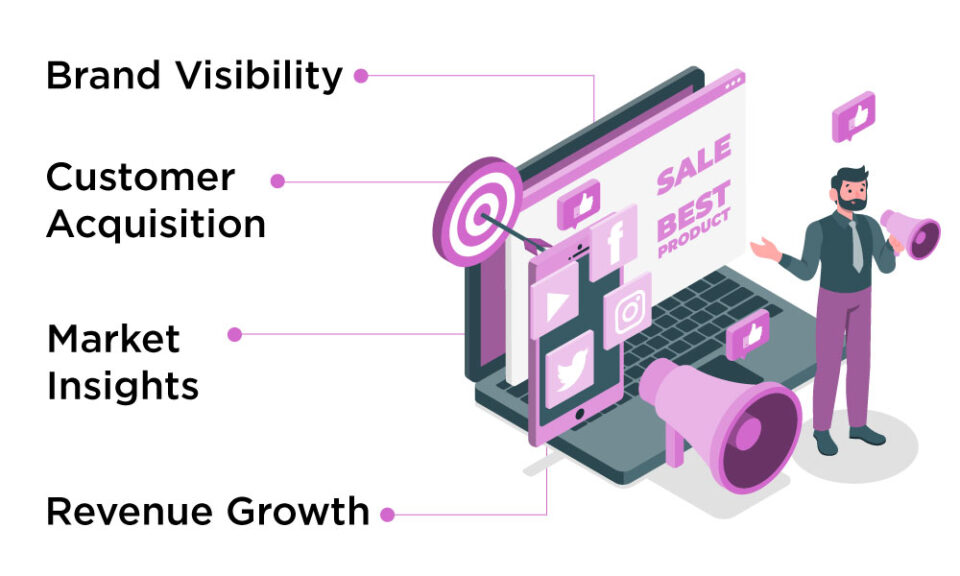What is an Ad Impression?
The number of times an ad is viewed or engaged with on a post, a piece of content, or any digital platform.
They are used in online advertisements. However, one should not confuse it with the number of clicks, as the ad impression doesn’t measure the number of clicks on an ad.
Impressions are undoubtedly one of the most critical marketing standards as they tell you how many potential customers the promoted content has reached. This information allows you to adjust your social media campaign strategy according to your requirements or goals.
How do Impressions Work?
An ad impression is one of the key metrics in online advertising. One impression is equivalent to a posted content being loaded or found once by the users. Ad impressions are the most convenient way to understand whether the ad is being seen and how many times it’s been seen. By knowing the number of ad impressions, the performance, marketers can evaluate effectiveness of their ad campaign strategies, which allows them to data-driven decisions to improve their efforts to make a bigger impact.
Why are Ad Impressions Important?
Ad impressions have a considerable significance in social media and advertising.
Now, we know how ad impressions are the measure of the reach of an ad to the customers.
Furthermore, impressions are directly involved in increasing brand awareness. Unlike clicks or conversions, which measure user engagement, ad impressions simply track the exposure of an ad. Suppose a user is shown an ad but doesn’t click the ad, it would still give the user exposure and would increase the familiarity and recognition about the brand.
Types of Ad Impressions
They can be categorized into several types, each offering different insights into the performance of a digital advertising campaign:
1. Served Impressions: These are ads delivered to a user’s device, regardless of whether they are viewed. Impressions served are often used to measure the reach of an ad campaign.
2. Viewable Impressions: Unlike served impressions; viewable impressions only count when an ad is in view on the user’s screen. According to the Media Rating Council (MRC), an ad is considered viewable when 50% of its pixels are visible on the screen for at least one second.
3. Paid Impressions: These impressions are tied directly to a cost-per-thousand (CPM) pricing model. Advertisers pay based on the number of times their ad is displayed, making paid impressions a key metric for budget planning.
4. Organic Impressions: Generated without direct payment, organic impressions typically result from content being shared or appearing in search results. They are often a byproduct of strong SEO and social media strategies.
Benefits of Ad Impressions
Ad impressions offer several advantages that make them a valuable metric in digital marketing:
1. Brand Awareness: One of the most significant benefits of it is its ability to boost brand awareness. By consistently displaying an ad to a large audience, businesses can increase their brand’s visibility and recognition.
2. Wide Reach: They help businesses reach a broader audience. Even if users do not click on the ad, the repeated exposure can leave a lasting impression, influencing future purchasing decisions.
3. Cost-Effective: For businesses operating on a CPM model, they can be a cost-effective way to gain exposure. Advertisers can reach thousands of potential customers at a relatively low cost, making it an attractive option for businesses with limited budgets.
4. Measurable Performance: Tracking them provides valuable data on how many people are being exposed to a campaign. This information can be used to refine targeting strategies and optimize ad placements for better performance.
Challenges of Ad Impressions
Despite their benefits, ad impressions are not without challenges:
1. Lack of Engagement Insight: They do not measure user engagement. While an ad might be displayed, there is no guarantee that users are paying attention or interacting with it, making it difficult to gauge the true impact of an ad.
2. Ad Fraud: The digital advertising industry faces significant challenges from ad fraud, including bots that generate fake impressions. This can lead to inflated metrics and wasted ad spend, as advertisers may pay for impressions that were never seen by real users.
3. Viewability Issues: Not all impressions served are viewable. Ads might load at the bottom of a page or in areas where users do not scroll, leading to impressions that technically count but offer no real value.
4. Ad Fatigue: When users are exposed to the same ad repeatedly, it can lead to ad fatigue, where the effectiveness of the ad diminishes over time. This can result in lower click-through rates (CTR) and reduced ROI.
The Impact of Ad Impressions on Business
They play a crucial role in the overall success of digital advertising campaigns, influencing several aspects of a business:

1. Brand Visibility: The more ad impressions a business generates, the more visible its brand becomes. This visibility is essential for brand recognition and can lead to increased customer loyalty over time.
2. Customer Acquisition: By reaching a broad audience, they can contribute to customer acquisition efforts. Even if immediate conversions don’t occur, repeated exposure can keep a brand top-of-mind for potential customers.
3. Market Insights: Analyzing their data provides businesses with insights into which platforms and ad formats work best for their target audience. This data can be used to optimize future campaigns, improving their effectiveness and efficiency.
4. Revenue Growth: While they alone don’t guarantee revenue, they are an important step in the customer journey. High impression counts can lead to increased traffic, higher conversion rates, and ultimately, revenue growth.
The Future of Ad Impressions
As digital marketing continues to evolve, the role of ad impressions is likely to change. Here are some trends that could shape the future:
1. Increased Focus on Viewability: With growing concerns about ad fraud and non-viewable impressions, advertisers will likely place more emphasis on viewable impressions. This shift will require better tracking technologies and stricter standards to ensure users see ads.
2. Programmatic Advertising: The rise of programmatic advertising, where ad placements are bought and sold through automated systems, will make them more targeted and efficient. Programmatic advertising allows for real-time bidding, ensuring that ads reach the right audience at the right time.
3. Cross-Platform Measurement: As users interact with ads across multiple devices and platforms, measuring ad impressions will become more complex. Future advancements in cross-platform measurement will enable advertisers to track impressions more accurately, providing a holistic view of campaign performance.
4. Personalization: Personalized advertising is expected to become more prevalent, with ad impressions tailored to individual user preferences and behaviors. This approach will increase the relevance of ads, making impressions more valuable and effective.
Conclusion:
Ad impressions are a fundamental component of digital marketing, offering businesses a way to measure the reach and visibility of their ads. While they provide significant benefits, including increased brand awareness and cost-effective exposure, they also come with challenges such as ad fraud and viewability issues. As the digital landscape continues to evolve, the future of ad impressions will likely involve more sophisticated measurement techniques and a greater focus on delivering meaningful, viewable impressions to the right audience.
By understanding the intricacies of ad impressions, businesses can better strategize their digital marketing efforts, ensuring they maximize the impact of their campaigns and stay ahead in the competitive online advertising space.
You may also like to read:
Top 10 Places Would You Be Sharing Your High-Quality Content
How to improve SEO in 2024: Top Tactics




